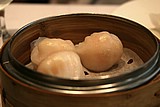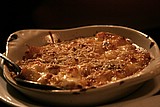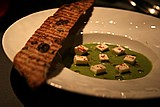Home |
Restaurants by City
|
Food Photography |
Archive | Philosophy |
![]()
Right now we are eating in Seattle, Washington.
|
Thursday
2006
Permalink
|
Chez Panisse, Berkeley, California, tasted on December 18, 2004 We've been spending quite a bit of time lately writing about what restaurants should do. It's not that we've ever run a restaurant of our own (or even seriously worked at one), but hopefully the opinion of passionate customers who advocate loyally for their favorite chefs and establishments counts for something. None of the ideas we're espousing here are particularly original. They all come from experiences we've had at some of the best eating establishments on the planet. Some of those restaurants are ones that you've heard of, some fly under the radar, undiscovered. But one that has stood for some of the core values that make restaurants great has been Alice Waters' Chez Panisse in Berkeley, California. I won't get into the history of the restaurant, but suffice to say that for anyone interested in food, this Berkeley restaurant is said to be a mandatory destination. And in fact, on that evening Chez Panisse turned out to be an iconic representation of the contrast between memorable and wonderful food and the bulk of uninteresting food you find in American restaurants. However, it wasn't how you might expect. There were five of us and we ordered most of the items on the menu. Trying everything is important so you can get a sense of the dimensions of the dishes across the menu. Understanding the range of flavors and textures is key to getting a picture of the restaurant. Two of the dishes we ate that evening were among the best I've ever had. When people ask me what I consider good food these two dishes are always ready examples. They had deep flavor, perfect temperature and texture, and I can remember how they taste to this day. How many dishes can you say that about? Were these some fancy truffle laden, caviar topped, champagne soaked, foie gras infested recipes? No. They were Brodo (chicken broth) and Roast Chicken. Here's what I wrote down about the Brodo, "deep, rich, exciting, super savory, rich, concentrated chicken flavor". Yes. Exciting chicken soup. On the Roast Chicken I wrote that this was "one of the best bites of chicken I've ever had. Drippingly juicy, crunchy crispy skin. Special. Hyper-savory and concentrated in flavor like the soup. If I had to break it down, these dishes were each: 1) deeply flavorful, 2) served while still fresh/hot - texture just right, 3) memorable. These were dishes that seemed worthy of the reputation that Chez Panisse had garnered. There were other things that were good. The bread was hearty fresh and rustic, with a slight tangy flavor on the finish. The green olives were excellent. The black ones had a flat bitter flavor and were unappetizing. Gil said that this was how Moroccan black olives were supposed to taste. I told him to consider me more educated. He countered that I was now less ignorant. Either way, they weren't my thing. The parmesan chunks were crystalline, creamy, and yummy. The simple goat cheese salad was way better than most salads you'll ever have at a restaurant. The bottarga we had on one of the pizzas had a simple but interesting and enjoyable flavor and texture. The pork had a nutty and clean favor and the braised lettuce that it sat on had just the right texture. The salmon and the pot roast however were devoid of flavor and not enjoyable. So of the four main courses we had, one was out of this world (the chicken), one was very good (the pork), and two were a waste of our time. Of our other dishes, the soup was fantastic, the pizza ranged from decent to ok. And the goat cheese and anchovies were unbalanced and forgettable. What should I conclude from this meal? On the one hand, the highs were high. On the other hand, the lows were what i could find at any restaurant that's doing a bad impression of what's people think constitutes good food these days. Furthermore, it was some of the simplest dishes that were the best, while the more complicated dishes broke down. Should I say, hey, no big deal, at least there were some standouts? Frankly, that's not where I end up. I get annoyed. Yes. Annoyed. I understand when a kitchen is not good enough to generate good food and all the food sucks. Maybe they lack creativity, or effort, or teamwork, or experience, or talent. But the soup and the chicken were clear signals that this kitchen lacked none of those things. All the more reason I was so irritated by how lame the pot roast and salmon dishes were. At least on that night the people cooking at Chez Panisse clearly had the ability to make world class food, they were just too lazy to do it consistently. Don't get me wrong, making food at this level, consistently night in and night out is unbelievably hard work (for which I have only the barest appreciation). At certain levels it can be considered "olympic" level competition. But shouldn't I expect that level of consistency, especially at a restaurant that is happy to rely on its reputation and legacy (not to mention charge a commensurate amount of money for the food)? And more importantly, shouldn't everyone else? I understand when the kitchen is trying out something new. Some friends of mine, say, why inflict it on a customer if it's not ready to leave the kitchen. Experiment on yourself. I believe that you need to do some experimentation on real customers as it's the only way to get real feedback. And as a customer I don't mind being the guinea pig as long as it's just one component of an overall accomplished set of dishes. And I tell myself that I can tell the difference between a dish that's in the process of finding it's center and a dish that is either a) as good as it's going to get, or b) a dish that could be better if people in the kitchen had bothered to actually taste the food before it went out to customers. Maybe I'm full of crap and can't tell the difference, but undeniably I walked out of Chez Panisse feeling that the kitchen just didn't care enough to do their best. Professional restaurant critics make me laugh with their faux disguises and fantasy that restaurants have no idea who they are. I know two things: 1) the kitchen can't make better food than it is capable of no matter who you are, and 2) at the best restaurants the kitchen wants to make the food great no matter who you are. They have pride in their work. And in the best cases, that pride comes through in the food served to you as often as possible. I'll eat at Chez Panisse again to see if they were having an off night. But I'll confess that I'm not in a huge hurry to go back. Though I do dream about that soup and chicken. Maybe I could get a couple of orders to go.
|
|||
Our Sponsors
Free Car Listings Hot Tubs Stools Saunas Bar Stools - Calendar and Event Schedules - Food Events and Calendars - Wine Events and Calendars - Digital Photography Resources - Software for Advertisers - Jewish Gifts and Judaica - Howard Stern Podcast - ponytailed blogger Jonathan Schwartz

Browse tastingmenu
Home |
Restaurants by City X |
Food Photography |
Archive | Philosophy |
![]()
Free eBooks: All About Apples
| Autumn Omakase
More:
Discussion |
Cool Food T-Shirts |
Ingredients
| Markets |
Recipes
Search |
Blog FAQ |
Other
Blogs
Best of tastingmenu
|
City View
Entry: July 6, 2006 |
Blue Plate
Entry: June 19, 2006 |
L'Atelier de Joël Robuchon
Entry: July 18, 2006 |
Browse by City
Boston | Chicago | Houston | Las Vegas | Los Angeles | Maui | New York | Philadelphia | Portland | San Francisco | Seattle | Toronto | Utah | Vancouver | Washington D.C.
Bangkok | Beijing | Hong Kong | Seoul | Tokyo
Amsterdam | Berlin | Italy | London | Madrid | Paris | Vienna
Browse by Month
2006
2005
2004
2003
2002
2001
Comments, questions, or feedback:
info / at / tastingmenu / dot / com
All pages Copyright (c) 2001-2006 tastingmenu.com
Last modified 01/30/07.




